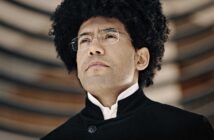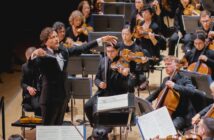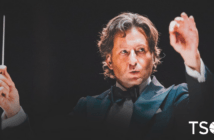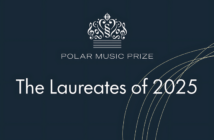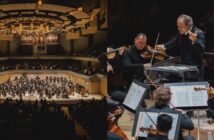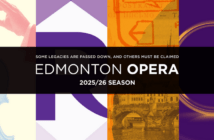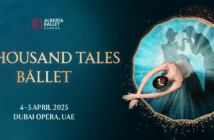
It is always a difficult business to “educate” the classical music audience without talking down to them on the one hand or talking over their heads on the other, and while some subscribers welcome non-musical elements in a concert, others hate them.
The Austin Symphony and conductor Peter Bay deserve full marks for making a valiant effort to both educate and entertain at their Long Center concert last week.
In the first half of the concert, we were given some background on the piece courtesy of the Chicago Symphony’s (CSO) Beyond the Score series, a multi-media production incorporating a giant screen over the orchestra, a narrator, two actors, a singer and a pianist. This innovative opening to the concert introduced us to Dvořák the man and the composer, and told us something about his approximately two-year stint (1892-95) in New York as head of the National Conservatory. More importantly, it explored all the elements that inspired Dvořák to create his most famous composition. In the second half, we had a complete performance of Dvořák’s Symphony No. 9 in E minor “From the New World.”
The Austin Symphony was in familiar territory with this programming, having participated in a symposium/festival called New Worlds: Dvořák in Search of America, a celebration of the Dvořák Centenary sponsored by the College of Fine Arts at the University of Texas in 2004. In that festival, the Austin Symphony also played the New World Symphony and there was much discussion about the American elements in the score and above all, about how Longfellow’s poem The Song of Hiawatha inspired the composer.
Beyond the Score Too Fond of the Familiar?
This installment of Beyond the Score was, presumably, written by the CSO’s creative director Gerard McBurney. (Not ‘Burney’ as listed in the Austin Symphony program book!) Visit the website for a full listing of past and future presentations.
What one notices right away is that nearly every piece given this multi-media treatment is already well-known to and beloved by symphony audiences everywhere. In other words, these are the very pieces least in need of elaborate and expensive extra-musical treatment in order to make them intelligible to contemporary listeners. That seems to me a basic problem with the concept.
For the record, there is one exception. Beyond the Score has also presented the Shostakovich Symphony No. 4 – exactly the sort of neglected and problematic repertoire that should be given special treatment. The San Francisco Symphony’s Keeping Score series is far more innovative in its choice of repertoire.
Beyond the Score More Fiction than Fact
In this Beyond the Score presentation of Dvořák’s New World Symphony, McBurney has concentrated on why it is called “From the New World” and made extensive use of Michael Beckerman’s entertaining but highly speculative book New Worlds of Dvořák.
The impression left by the Beyond the Score presentation is that the middle movements of the symphony are very closely related to the Hiawatha story as told in Longfellow’s poem. We are also left with the impression that Dvořák used actual African-American songs in the symphony. Neither impression is factual.
Let’s take the Hiawatha case first. All this Hiawatha business got started around the time of the eagerly anticipated premiere of the New World symphony in 1984. Music critic Henry Krehbiel attended rehearsals, interviewed Dvořák, and wrote about the piece at some length.
On good authority – Dvořák himself – Krehbiel stated that the slow movement was inspired by Longfellow’s account of Hiawatha’s wooing/courtship of Minnehaha. That claim opened the door to all sorts of research into what passage in the music corresponded to what passage in the poem. But Dvořák would say no more.
In New Worlds of Dvořák, Beckerman explores the Hiawatha connections in great detail, and ultimately concludes that Dvořák meant what he said, that Hiawatha was “an inspiration” and only an inspiration, and that there is no detailed Hiawatha program to be uncovered in the symphony.
Beckerman also reminds us that when one of Dvořák’s American students went to stay with him for several months in Bohemia, for the primary purpose of discovering the meaning of the symphony, he came away empty-handed. The student, Harry Patterson Hopkins, went for long walks in the woods with Dvořák every day. In Beckerman’s words: “He found out nothing.”
And did Dvořák use “negro spirituals” in the symphony? It has often been stated that the famous tune that begins the Largo is such a tune. But as much as McBurney tries to throw dust in our eyes in Beyond the Score, this is more nonsense.
Dvořák became aware of “negro” music through a young man named Harry Burleigh. A student at the National Conservatory during Dvořák’s tenure there, his father had been a slave, and Harry had sung some spirituals and plantation songs for Dvořák. Burleigh made it very clear that while Dvořák was interested in this music, it is impossible to find any note for note quotations in the symphony.
Of course that didn’t stop the critics from claiming to find them. What did Dvořák have to say on this subject? In a letter written in 1900, he reflected his annoyance with the whole enterprise: “But forget that nonsense, the notion that I used Indian and American melodies, because it is a lie! I tried only to compose in the spirit of those national American melodies.”
There was more foolishness about Wagner being imitated in the brass chords which begin the Largo, and in the use of period film of a sea voyage to accompany the music in the first movement, suggesting that this music was inspired by Dvořák’s journey to America.
Mention was made by the narrator of a tuba, curiously used only in the Largo movement, yet no mention was made of an even stranger instrumental anomaly in the symphony – the piccolo – which is used for only 4 bars in the first movement, and nowhere else in the piece!
Taking Beyond the Score Beyond the Familiar
Whether serious or silly, all these stories and anecdotes are amusing and colorful and help to enliven multi-media presentations.
I spoke to several members of the audience after the presentation. They certainly enjoyed it. They felt they learned more about the composer and they embraced the use of visual media and live actors; upon close questioning, however, it also became apparent that they had embraced the still debated message McBurney conveyed, whether deliberately or inadvertently, as factual. i.e., that 1) the symphony quotes “negro” spirituals, and 2) the symphony tells the story of Hiawatha and Minnehaha.
So much for music education.
From my perspective, Beyond the Score presentations in this simplistic vein are both unnecessary and misleading, and do little to advance the cause of music education. That said, one can imagine insightful treatments of less popular pieces such as Liszt’s A Faust Symphony, Messiaen’s Turangalîla, Britten’s Spring Symphony, etc. that would benefit enormously from a Beyond the Score multi-media programming component.
In the End, The Sound, not the Story Stirs the Heart
After intermission, we experienced the music without the media, and it was a pleasure. In spite of the familiarity – over-familiarity? – of the piece, Peter Bay and the Austin Symphony gave it a fresh and committed performance.
The orchestra was without its regular concertmaster Jessica Mathaes. Former concertmaster Eugene Gratovich led with authority. All sections were in top form. Special kudos to the horn section, and to the double basses whose difficult four-part chords at the end of the Largo were perfectly in tune, and, of course, to the excellent English horn soloist who played the famous tune earlier in the same movement, with beautiful tone and phrasing.
For Those Wanting More…
Michael Beckerman’s book was published in 2003 by W.W. Norton. Another useful book edited by Beckerman is called Dvořák and His World (Princeton University Press., 1993). Dvořák the man is brought vividly to life by the Czech-Canadian novelist Josef Skvorecky in Dvořák in Love, first published in 1986.
Paul E. Robinson is the author of Herbert von Karajan: the Maestro as Superstar, and Sir Georg Solti: His Life and Music. NEW for friends: The Art of the Conductor podcast, “Classical Airs.”
Photo of Maestro Peter Bay by Marita


